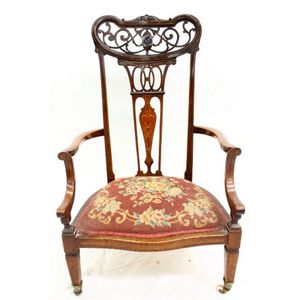Louis XVI Style Petit Point Fauteuil
You must be a subscriber, and be logged in to view price and dealer details.
Subscribe Now to view actual auction price for this item
When you subscribe, you have the option of setting the currency in which to display prices to $Au, $US, $NZ or Stg.
- Rail - A term used by cabinet makers for the horizontal sections of the frame of an item such as a chair or settee which have a front rail, a back rail and two side rails, and also on a door or carcase, where the rails are joined to the vertical framings.
- Oak - Native to Europe and England, oak has been used for joinery, furniture and building since the beginning of the medieval civilisation. It is a pale yellow in colour when freshly cut and darkens with age to a mid brown colour.
Oak as a furniture timber was superceded by walnut in the 17th century, and in the 18th century by mahogany,
Semi-fossilised bog oak is black in colour, and is found in peat bogs where the trees have fallen and been preserved from decay by the bog. It is used for jewellery and small carved trinkets.
Pollard oak is taken from an oak that has been regularly pollarded, that is the upper branches have been removed at the top of the trunk, result that new branches would appear, and over time the top would become ball-like. . When harvested and sawn, the timber displays a continuous surface of knotty circles. The timber was scarce and expensive and was used in more expensive pieces of furniture in the Regency and Victorian periods. - Patera - A small decorative device, used as ornament in Neo-classical style furniture. Patera (or paterae) are usually round or oval, in the form of stylized rosettes. In the best pieces they are carved directly into the timber, otherwise they applied to the surface. Sometimes painted or inlaid motifs in the style are referred to as patera. Also known as a boss or a rosette.
- Fluting - A form of decoration found on many pieces of furniture, as well as ceramics, silver and clocks, in which round-bottomed grooves, of varying width and depth, are let into columns, pilasters, legs. As a general rule, flutes are cut in the vertical, though they may follow a turned leg in a spiral pattern. In cross-section, they may be described as a series of 'U' shapes, rising and narrowing at each end of the groove. Fluting is the opposite of reeding, with which fluting is often associated.
- Petit Point - Petit point embroidery is a type of needlework that is characterized by small, delicate stitches worked onto a fine canvas or mesh fabric. The stitches used in petit point embroidery are typically very small and precise, and are worked in diagonal rows to create a smooth, even surface.
Petit point embroidery is often used to create intricate designs and patterns, such as floral motifs, landscapes, and portraits. The embroidery can be done in a variety of colours and can be quite detailed and realistic.
The technique of petit point embroidery has been used for centuries in various forms of decorative art, including tapestries, cushions, and clothing. It was particularly popular in the 17th and 18th centuries in Europe, where it was used to create elaborate wall hangings and furniture coverings.
Petit point embroidery is still practiced by many artisans and is used to create a wide range of decorative items, including jewellery, handbags, and home decor. The technique requires patience and skill, as the small stitches can be time-consuming to work and require a steady hand. - Bow Front - The front is shaped in a gentle curve or bow. Introduced during the 18th century, the bow-front is associated with furniture of the Hepplewhite and Sheraton period, though of course the form continued to be used throughout the 19th century. Bow-fronted pieces are usually veneered, although some were cut from the solid wood. Where veneer is used, the carcase is cut either from pine or deal, or sometimes the front was built up and shaped with small timber 'bricks'. Commonly used on various types of furniture including chairs, settees, chests, side tables, sideboards and display cabinets.
This item has been included into following indexes:
-
chairs, singles / pairs / threes, style or period
- fauteuils (arm chairs) 240
- French 949
- Louis XVI 186
- chairs, singles / pairs / threes, timber - oak 488
Visually similar items

A Edwardian mahogany nursing chair, c.1910, with inlay and upholstered with tapestry, some minor fretwork damage, aged upholstered tapestry complete, white porcelain castors in tact, height 96 cm

A pair of French late 19th century Louis XVI style gilt wood fauteuils.

A set of six cedar Victorian balloon back chairs, mid 19th century, the circular backed chairs with stuffover seats raised on knopped and slender baluster legs to toupie feet, upholstered in olive green floral cut velvet, height 88 cm, width 50 cm, depth 5

A fine Edwardian inlaid rosewood open arm chair, circa 1900, of elegant sinuous lines with Art Nouveau influence, having a shield style back with scrolled cresting rail above an inlaid vasiform splat flanked by slender curvaceous splats, the arms with exag
